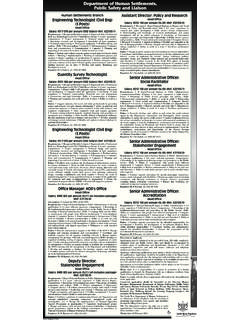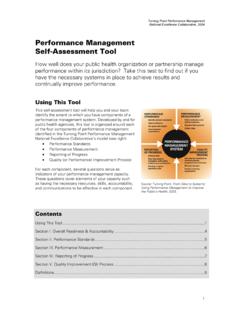Transcription of Quantified Risk Assessment of Aircraft Fuelling Operations ...
1 Quantified Risk Assessment ofAircraft Fuelling OperationsA Report Prepared by:WS ATKINS SAFETY & RELIABILITYfor and on behalf of:THE HEALTH & SAFETY EXECUTIVEP repared by:..Checked by:.. P FewtrellA PetrieILinesN CowellA LivingstonC JonesB AtuobengAuthorised by:..J MatherWS Atkins Safety & ReliabilityWS Atkins HouseBirchwood BoulevardBirchwoodWarringtonCheshireWA3 7 WATel:(01925) 828987 Fax:(01925) 828153 Report No:AM5204 Issue No:FinalDate:July 2000AM5204 Issue Final; Date: July 2000iISSUE RECORD SHEETI ssueDatePageParaCommentsDraft13 August 1998 Issue of Draft FinalJuly 1999 Incorporating responses tothe comments on the draftreportFinal DraftApril 2000 Incorporating responses tothe comments on the draftfinal reportFinalJuly 2000 Incorporating responses tothe comments on the finaldraft reportAM5204 Issue Final.
2 Date: July 2000iiQuantified Risk Assessment ofAircraft Fuelling OperationsChris R Jones, Paul Fewtrell, Andy Petrie, Ian Lines, Nicola Cowell, Andy LivingstonWS Atkins Consultants LtdBirchwood BoulevardBirchwood, WarringtonWA3 7 WARecently there have been a number of major fuel spills on the ramp at UK airports. Both theHealth and Safety Executive (HSE) and the Civil Aviation Authority (CAA) were interested inestablishing the level of risk posed by Fuelling , Aircraft maintenance and defuelling operationscarried out on the ramp. As a result the HSE commissioned WS Atkins to undertake aQuantified Risk Assessment of Aircraft Fuelling Operations . With this information the HSE feltthat they would then be in a better position to assess what, if any, risk reduction measures mightbe principal objectives of the project were to: obtain details of historical incidents world-wide which resulted in a fuel spill during aircraftfuelling; assess the fire and/or explosion risk from Aircraft Fuelling Operations involving Jet A-1; and recommend cost effective risk mitigation measures for implementation at UK report describes the results of this project.
3 This study has identified the failure eventswhich can result in a fuel spill on the ramp during Fuelling , Aircraft maintenance and defuellingactivities. Frequency data has been derived from a review of historical information on spillsfrom a number of UK airports. The main consequence of a release of fuel was determined to bea pool fire if the spill were has been assessed that the risk from Aircraft Fuelling is not negligible but lies in the ALARP region. In terms of both individual and societal risk, hydrant Fuelling presents a higher risk thanfuelling using a and safety management measures have been recommended to reduce the risk. Insome cases cost benefit analysis arguments have been used to support the selection of aparticular measure. The recommended measures have been presented as: measures specifically designed to reduce the major contributors to the risk; and additional safety management measures which are not specifically related to the major riskcontributors but which need to be the course of the study it was clear that the UK Aviation Industry is pro-active in tryingto reduce the risks during Aircraft Fuelling .
4 Many of the initiatives adopted or proposed,particularly by the UK Oil Industry, are in-line with those identified by this report and the work it describes were funded by the Health and Safety Executive. Itscontents, including any opinions and/or conclusions expressed, are those of the authors aloneand do not necessarily reflect HSE Issue Final; Date: July 2000iiiTABLE OF OF DESCRIPTION OF AN AIRPORT ASSOCIATED WITH AN Aircraft RELATING TO JET A-1 AND PROPERTIES OF JET ASSOCIATED WITH JET Operations CARRIED OUT AT Fuelling HYDRANT Fuelling Fuelling SAFETY AUTHORITY SUPERVISION OF TURNROUND A FUEL SPILL31AM5204 Issue Final; Date: July OF FUEL SPILL FAILURE OF HISTORICAL FAILURE EVENTS DUE TO HARDWARE SPILL EVENTS DUE TO SMS FUEL SPILL CONTROL SAFETY OF Fuelling SAFETY SYSTEM LIKELIHOOD OF A RATE CONSEQUENCES FOLLOWING A AND EXPLOSION LIKELIHOOD OF CONSEQUENCES9310.
5 Assessment OF THE OF THE PEOPLE AT OF THE risks TO BE OF OF PEOPLE EXPOSED TO THE PROBABILITY FOR FUEL SPILL OF SPILL OF INDIVIDUAL OF SOCIETAL OF RISK WITH VARIOUS COST BENEFIT DISCUSSION107AM5204 Issue Final; Date: July 2000v11. RISK REDUCTION RISK REDUCTION MEASURES FOR HYDRANT RISK REDUCTION MEASURES FOR Aircraft MAINTENANCEON THE RISK REDUCTION SAFETY MANAGEMENT MEASURES11812. AVIATION INDUSTRY TO REDUCE THE LIKELIHOOD OF A TO REDUCE THE INVENTORY OF A SPILL12113. SUMMARY AND CONCLUSIONS12314. RECOMMENDATIONS12415. REFERENCES127 APPENDIX IPHOTOGRAPHS OF HYDRANT Fuelling EQUIPMENT129 APPENDIX II LITERATURE SEARCH SOURCES133 APPENDIX IIIPRELIMINARY HAZARD IDENTIFICATION SHEETS135 APPENDIX IVCALCULATIONS FOR TABLE VCALCULATIONS FOR TABLES AND VIINDIVIDUAL AND SOCIETAL RISK CALCULATIONS153 GLOSSARY157AM5204 Issue Final.
6 Date: July 2000viABBREVIATIONS AND ACRONYMSAAIBAir Accidents Investigation BranchANOAir Navigation OrderACIA irports Council InternationalAOAA irport Operators AssociationAPIA merican Petroleum InstituteAPUA uxiliary Power UnitsATMAir Transport MovementBABritish AirwaysBAAB ritish Airports AuthorityCAAC ivil Aviation AuthorityCAPC ivil Aviation PublicationDoTDepartment of Department of TransportationEFSSE mergency Fuel Shut Down SystemESBE mergency Shut down ButtonFAAF ederal Aviation Administration (USA)GPUG round Power UnitHSEH ealth and Safety ExecutiveIATAI nternational Air Transport AssociationICAOI nternational Civil Aviation OrganizationIPInstitute of PetroleumJAAJ oint Aviation AuthoritiesJIGJ oint Inspection GroupLPAL ocal Planning AuthorityNIGN ational Interest Group (HSE)NATSN ational Air Traffic ServicesNTSBN ational Transportation Safety Board (USA)RHSL Ringway Handling Services LimitedQRAQ uantified Risk AssessmentTITransport IndexUKUnited KingdomUSUnited States of AmericaACKNOWLEDGEMENTSThe authors gratefully acknowledge the assistance provided by all those individuals andorganisations who have provided information for the purposes of this study.
7 Particular thanksmust go to:Various UK AirportsBAAC ivil Aviation AuthorityInstitute of PetroleumAir Accident Investigation BranchBritish AirwaysRingway Handling ServicesEsso & ShellAviation Safety Web Pages11. BACKGROUNDThe main type of fuel used for both civil and military Aircraft is Jet A-1 (a kerosene type fuel).This is a low volatility fuel which is more difficult to ignite ( requires a more powerfulignition source) than aviation gasoline (AVGAS). The use of AVGAS is becoming confined tolight Aircraft . A number of major fuel spills of aviation Jet A-1 fuel have occurred at variousairports around the world and in the UK, over the last 25 years. Such incidents have beenreported at Barbados, Lagos, Denmark, Antigua, New Zealand and Australia.
8 Failures duringfuelling Operations of Aircraft are not uncommon and have included: underwing couplings becoming detached from the Aircraft ; nozzle quick disconnects separating; vehicle impact damage to hydrant couplers; failure of hydrant couplers due to incorrect re-assembly after being modified; hose ruptures; failure of valve or poppet to close; and accidental disconnection of a coupling after the failure of an the Health and Safety Executive (HSE) and the Civil Aviation Authority (CAA) areinterested in establishing the level of risk posed by Fuelling and defuelling Operations . The HSEcommissioned WS Atkins to carry out a Quantified Risk Assessment (QRA) of Aircraft fuellingoperations. The replacement of AVGAS by Jet A-1 in the past was a significant factor inreducing the risk during Fuelling mainly because it significantly reduced the likelihood ofignition.
9 It also reduced the speed of flame spread across the spill increasing the probability ofescape for the people around the OBJECTIVES The overall objective of this project was to carry out a study of the potential risks from majorfuel spills on the apron at UK overall objective can be broken down as follows: obtain details of historical incidents world-wide which resulted in a fuel spill during aircraftfuelling; assess the fire and/or explosion risk from Aircraft Fuelling Operations involving Jet A-1; and recommend cost effective risk mitigation measures for implementation at UK SCOPE OF WORKThe scope of work included: a literature search to identify historical incidents world-wide which resulted in a Jet A-1 fuelspill during Aircraft Fuelling ; conducting a Quantified Risk Assessment (QRA) of the two main methods of aircraftfuelling ( hydrant Fuelling and Fuelling using a refueller); identification of potential risk mitigation measures, conducting a cost benefit analysis whereappropriate and presenting the most cost effective measures; identification of areas where further study and additional control measures may bejustifiable; and producing a report summarising the findings of the project.
10 Fuelling and defuelling Operations inside hangars have been excluded from this study. Also theenvironmental risk from spills of Jet A-1 has not been assessed. The financial consequences of a spill incident have not been included in this study and so thebusiness risk has not been calculated. For information: Cost of incidents For a major un-ignited spill the costs might include: Direct costs cost of clean-up operation, including cleaning the outside of the Aircraft affected; and cost of replacing damaged equipment inlet coupler, hydrant, hoses etc. Indirect costs cost of Aircraft delay; and cost of loss of use of stands affected. For a major spill which catches fire, the costs might include all of the above plus: Direct costs possible Aircraft repair costs. In an incident in Barbados, a wing and two engines on aBoeing 747 had to be replaced at an estimated cost of $10 million (in 1983); and cost of providing a substitute Aircraft .











